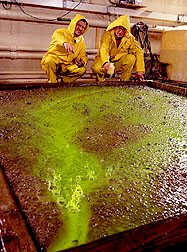This page has been archived and is being provided for reference purposes only. The page is no longer being updated, and therefore, links on the page may be invalid.
|
|
Model Provides Major Advance in Controlling Water ErosionBy Hank BeckerApril 30, 1997 WASHINGTON, April 30--A new computer model gives land managers, environmentalists, educators and policy makers worldwide a powerful tool to help combat water erosion of cropland, a U.S. Department of Agriculture scientist says. "WEPP--short for the Water Erosion Prediction Project--represents a major advance in our ability to evaluate how the different ways we use the land can affect soil erosion by water," said C. Richard Amerman, national program leader for soil erosion at USDA's Agricultural Research Service in Beltsville, Md. WEPP is a project of the USDA's Forest Service, Agricultural Research Service and Natural Resources Conservation Service and the U.S. Department of the Interior’s Bureau of Land Management. WEPP is the result of 10 years of research by dozens of USDA and USDI scientists, plus cooperators from universities and several foreign countries. In tests, the model's predictions have been validated by 1,000 plot-years of data on water runoff and erosion from 12 sites and 15 watersheds around the United States. A plot- year is a year’s worth of data on a specific plot of land. "WEPP provides needed new technology to better assess how much erosion occurs and how much sediment is deposited on cropland, rangeland and forest land," said ARS agricultural engineer John M. Laflen, the WEPP project leader. Now based at the agency's National Soil Tilth Laboratory in Ames, Iowa, Laflen played a lead role in developing and testing the erosion prediction technology at the ARS National Soil Erosion Research Laboratory at West Lafayette, Ind. "WEPP predicts rill and interrill erosion separately, which other prediction tools are not designed to accommodate," Amerman noted. Rill erosion is caused by water running over the soil, while interrill erosion is caused by raindrop impact and splash. The researchers describe the latest stages of WEPP’s development and testing in an article in the April issue of Agricultural Research, ARS’ monthly publication. The story can be viewed on the World Wide Web at: /is/AR/archive/apr97/wepp0497.htm The Forest Service has already used the model to address site-specific erosion problems, such as the impact of timber harvesting on sediment in streams. The BLM will use WEPP in developing strategies to control erosion from rangelands. The WEPP model has already been demonstrated to groups in Russia, Costa Rica, Canada, China, Austria, Portugal, Mexico, India, Italy, Ukraine, Brazil, Uganda, Australia and Belgium. "WEPP has been used on every continent but Antarctica," said Laflen. Users can obtain the most current WEPP model release, documentation, information and patches on the World Wide Web at: http://soils.ecn.purdue.edu:20002 The model is also available from Laflen on a multi-media CD-ROM. Scientific contact: John Laflen, ARS-USDA National Soil Tilth Laboratory, 2150 Pammel Dr., Ames IA 50011, phone (515) 294-8327; fax 294-8125, e-mail laflen@ecn.purdue.edu. |

